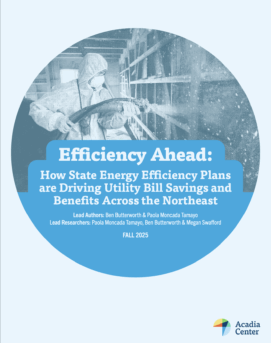Efficiency Ahead: How State Energy Efficiency Plans are Driving Utility Bill Savings and Benefits Across the Northeast
Acadia Center announces release of new report “Efficiency Ahead: How State Energy Efficiency Plans are Driving Utility Bill Savings and Benefits Across the Northeast.”
Acadia Center’s latest report highlights the essential contributions energy efficiency programs make to stabilizing costs, benefitting ratepayers, and diversifying the energy mix in seven states in the northeast.
Efficiency Ahead further recommends how standardizing metrics by states for program measurement, evaluation, and reporting would increase value.
ROCKPORT, ME – Acadia Center announces its new report: Efficiency Ahead: How State Energy Efficiency Plans are Driving Utility Bill Savings and Benefits Across the Northeast. This new analysis takes a closer look at the most recent energy efficiency plans developed by the six New England states and New York. It examines program investment levels, projected benefits and energy savings, cost-effectiveness levels, the impact of recent proposed funding cuts, and states’ progress relative to their peers on criteria like per-capita investment levels.
“State energy efficiency programs make a major contribution to the energy system as a low-cost resource, yet face a pivotal juncture in the northeast region,” said Jamie Dickerson, Senior Director, Climate and Clean Energy Programs. “Consumer affordability is front of mind for consumers and policymakers with rising energy prices. Other energy resources are rising in cost, yet cuts to ratepayer funded programs – which reduce system costs – have been threatened and implemented by leading states. It is more important than ever for policymakers, advocates, program administrators, and consumers to understand the value and evolving role of energy efficiency resource acquisition and shape the future trajectories of the programs to meet the emerging needs of the region.”
Each state in the Northeast operates and administers energy efficiency programs funded via electricity and natural gas bills to deliver energy efficiency and electrification improvements to customers. These ratepayer-funded energy efficiency programs have been and remain the largest source of investment in efficiency and building decarbonization for the region. These state programs have been operating for decades and provide major overall benefits in the form of reduced overall building energy consumption, energy cost savings to residents and businesses, reduced peak demand stress on the region’s electricity grid, and reductions in greenhouse gas (GHG) emissions, in addition to significant job creation and economic development increases.
The analysis conducted by Acadia Center in this report draws on publicly available data reported in each state’s three-year energy efficiency plan, annual program reports, and related filings. The analysis in the report yielded the following findings for program activity in the next three years:
- Record-level investments and lifetime benefits: Seven states poised to invest almost $10 billion in efficiency overall, with New England programs alone generating an estimated $19.3 billion in lifetime benefits.
- Significant electricity and fuel savings: New England and New York combined are expected to realize 700 trillion British thermal units (TBtu) in lifetime savings across all fuels, including 20 terawatt-hours (TWh) of electricity savings (lifetime) from efficiency investments in New England—equivalent to 5.2 million homes using natural gas for one year in New England.
- Wide range in per-capita investments by state: Program budgets range from $149 per capita in New York State to $631 per capita in Massachusetts—revealing differences in population, portfolio mixes, cost-effectiveness screening, and overall program ambition.
- Missed benefits from recent budget cuts: Massachusetts will lose out on $1.49 billion in lifetime benefits, 20 TBtus of energy savings, and 1.8 million metric tons (MMT) of carbon dioxide equivalent (CO2e) emissions by cutting $500m in program budgets. Rhode Island too faces cuts of 30% that would lose the state some $92m in benefits.
- Strong ongoing cost-effectiveness: Each dollar spent on efficiency yielding $2.93 in benefits across New England, on average—indicating an opportunity to increase investment levels further and acquire deeper cost-effective savings across the region.
- Major contributions to the region’s grid: Electric savings will help the region continue meeting a substantial portion of annual electric load via energy efficiency (20.6 TWh saved in 2023, or almost 15% of gross load).
While the benefits delivered by these programs are impressive, state program data were not easy to compile, and cross-state comparisons are made quite challenging by significant variations in reporting methodologies and data formatting across states. Cross-state collaboration to enable more uniform reporting would enable stakeholders to better communicate the significant positive benefits these programs are having on a regional scale.
“State energy efficiency programs are well positioned in the coming years to reduce overall building energy consumption, deliver energy cost savings to residents and businesses, reduce peak demand stress on the region’s electricity grid, and deliver reductions in greenhouse gas (GHG) emissions—all despite the changing overall landscape for efficiency investments and available funding sources,” said Ben Butterworth, Director of Climate, Energy, and Equity Analysis at Acadia Center and a lead author on this report. “Looking ahead, improving program design and administration can achieve even larger consumer and system benefits.”
MEDIA CONTACT
Jamie Dickerson
Senior Director, Climate and Clean Energy Programs
jdickerson@acadiacenter.org; 401-276-0600 x102



















